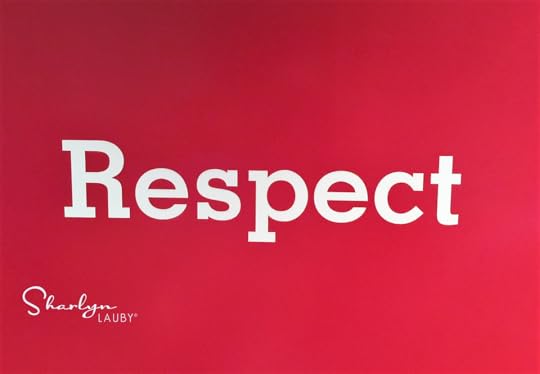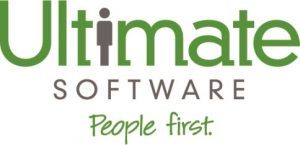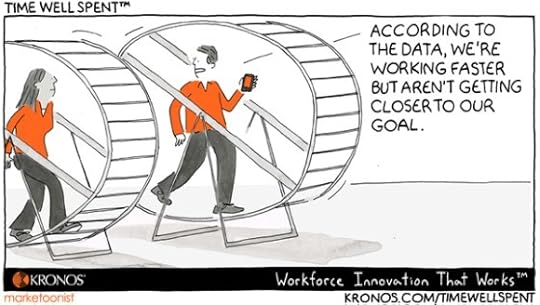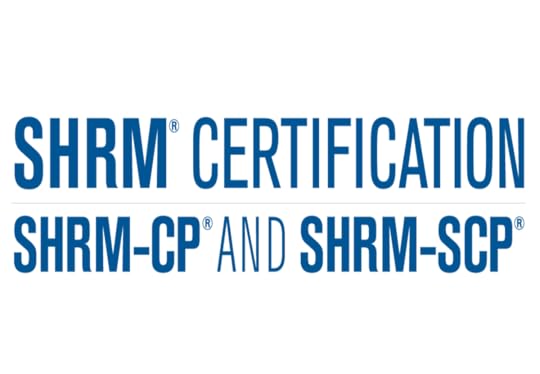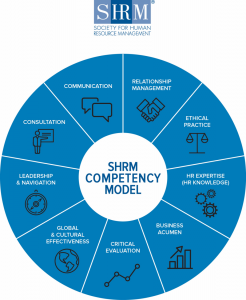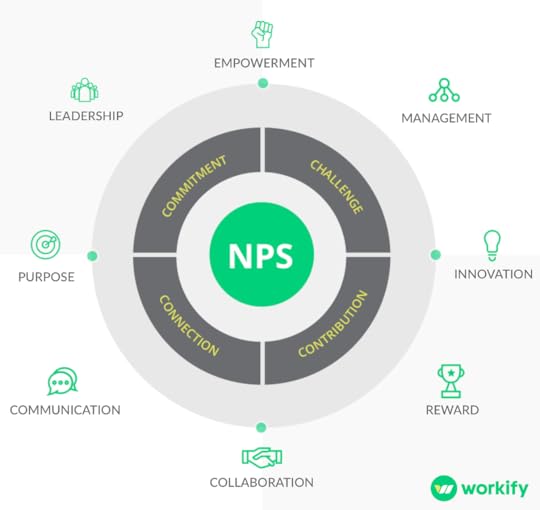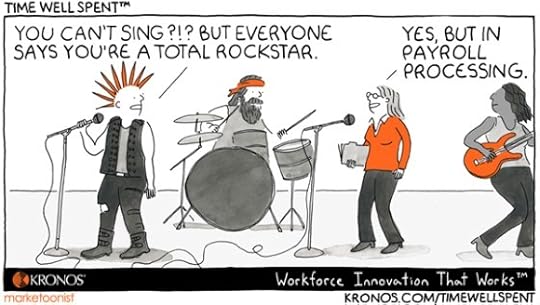Sharlyn J. Lauby's Blog, page 129
October 8, 2017
Women in Leadership: Creating an Inclusive Community of Interest
Communities of interest (sometimes referred to as affinity groups or employee resource groups) are exactly what you would think. They are groups of people who share a common interest, experience, or passion. The group is formed to share ideas and thoughts. Organizations have supported affinity groups for decades.
There was a recent article in Bloomberg Businessweek titled, “Deloitte Thinks Diversity Groups are Passé”. Regardless of your opinion about communities of interest, I think it’s worth reading. My takeaway is that, regardless of what you name the group, how the group is structured and supported is the key to its success.
One organization that understands this is Ultimate Software. They are a leading provider of cloud-based human capital management solutions, with more than 33 million people records in the cloud. The company is ranked #7 on Fortune’s 100 Best Companies to Work For list and #2 on People’s 50 Companies That Care list. I had the opportunity to chat with Vivian Maza, chief people officer at Ultimate Software. Viv has been with Ultimate since 1990 and plays a significant role in fostering the company’s unique culture.
During this year’s HR Technology Conference, Viv will be speaking about finding, supporting, and developing the next generation of women leaders as part of the event’s Women in HR Technology pre-conference workshop.
Why did Ultimate Software create a “Women in Leadership Community”? How do employees learn that the community exists?
 [Maza] We established our Women in Leadership (WIL) group in 2015 as Ultimate’s second official Community of Interest. These companywide social-networking groups promote inclusivity, equality, respect, and care for all individuals, and align with Ultimate’s ‘People First’ core philosophy. We now have four Communities of Interest, having just established our newest group, UltiHOPE, for cancer patients, survivors, and caregivers. In addition to WIL and UltiHOPE, we have PrideUS for the LGBTQIA community and UltiVETS for veterans and active service members.
[Maza] We established our Women in Leadership (WIL) group in 2015 as Ultimate’s second official Community of Interest. These companywide social-networking groups promote inclusivity, equality, respect, and care for all individuals, and align with Ultimate’s ‘People First’ core philosophy. We now have four Communities of Interest, having just established our newest group, UltiHOPE, for cancer patients, survivors, and caregivers. In addition to WIL and UltiHOPE, we have PrideUS for the LGBTQIA community and UltiVETS for veterans and active service members.
The mission of WIL is to help women at Ultimate, and in our communities, reach their maximum potential through mutual support, collaboration, and empowerment. About half of Ultimate’s employees are women and more than 40 percent hold leadership positions (manager or above), so it was clear a Community of Interest for our females—with opportunities for our male employees to participate, too—would greatly benefit all our people.
We actively promote WIL through several channels to ensure current and new employees always know about all the great ways to get involved. This includes channels such as companywide emails, an interactive space on our employee intranet, and community service outings sponsored by WIL. We also speak about WIL and all our Communities of Interest during our two-day New Hire Ultimization, where we fly all new employees to our headquarters in South Florida to learn about our company and our culture.
How is the leadership community structured (i.e. can anyone join the community, how do they sign up, what happens in the community, etc.)?
[Maza] Membership is open to any Ultimate employee, and everyone is encouraged to participate. There’s no formal signup process—employees can join at any time simply by attending a WIL event. There are several events hosted each month at our various office locations—including South Florida, California, Georgia (Atlanta and Alpharetta), and Toronto—and we also have regional programs tailored specifically to our virtual women (there are currently more than 950 virtual WIL members). These events include everything from guest speakers, lunch and learns, book clubs, wellness retreats, and group exercise classes to arts and crafts outings, film screenings, networking events, workshops for building professional skills, volunteering at nonprofits, and organizing charity drives.
We also have an executive committee consisting of myself and several executives from across Ultimate, and employees who are interested in holding leadership positions within WIL have the opportunity to join one of our subcommittees representing each location, including virtual members. Subcommittee members are nominated by their peers, and then our executive committee gives final approval. These members oversee the planning and execution of local WIL events, provide ongoing communications to fellow members and Ultimate employees, and help keep WIL running smoothly throughout the year.
Does the company have any goals or outcomes that they are trying to measure with Women In Leadership?
[Maza] WIL is an ongoing, ever-evolving effort to empower women everywhere and to support their success in their professional careers and personal lives. So, in many ways, our work is never really ‘done’. Just as Ultimate will always put people first and continue to care for our employees in every way possible, we will continue to support women through WIL. We’ll continue to work hard every day to do more for women—in tech, business, and life.
This past year, we introduced the theme ‘Aspire to Inspire’, with an underlying goal to do just that throughout WIL and Ultimate, and beyond our walls. One amazing example of this is the introduction of Ultimate’s new Athena Scholarship, sponsored by WIL. We will now be offering two annual college scholarships of up to $20,000 each to graduating daughters of Ultimate employees, as well as rising seniors who will be graduating high school next year. The scholarships will be awarded to young women who either pursue studies in tech (such as computer science, engineering, programming, user experience and test programming, and user experience design) or demonstrate superior leadership skills in their school and/or community, with the potential to become a woman leader. We are thrilled for this opportunity to make such a meaningful impact on young women as they build successful futures.
Since the Women In Leadership community started, has there been anything that surprised you (an outcome that you didn’t expect)?
[Maza] The level of dedication, care, respect, and support for one another demonstrated throughout WIL, and throughout Ultimate, continues to warm my heart every day. We truly have the best people at Ultimate, and their level of commitment to people—their colleagues and their communities—knows no bounds. They’re always joining together for the greater good of others, and even when we think we’ve seen the most amazing examples of compassion and support from our employees, they continue to amaze us.
I’m proud of what WIL has become, from our humble beginnings to the growing levels of involvement we see today, with hundreds of women (and even men) throughout our company participating in WIL. We’re seeing more and more people empowered every day through our program, being promoted into leadership positions within Ultimate, and making significant differences in the lives of so many.
What’s one piece of advice you would give to an organization considering a “Women in Leadership” Community?
[Maza] Stay committed. Stay committed to your people, work hard to protect the group and preserve your company’s culture, and continue to believe in the group’s collective power. If you really believe in it, your employees will believe in it.
You, as a company, very much set the tone—when your people know you care about the group’s success and you provide your people with the tools and resources to drive that success, they’ll care about the group and take it to levels you never thought possible. WIL has grown so much in just a short time, and it’s all because of the dedication and passion of our employees.
Ultimate set the foundation and we provide our support along the way, but it’s our people who’ve really taken complete ownership of this group and have worked together to shape WIL into so much more than we could have ever done or envisioned by ourselves.
A HUGE thanks to Viv for sharing her experience with us. If you want to learn more, be sure to register for the Women in HR Technology pre-conference workshop. It was incredibly popular last year, so seats will go fast!
And if you’re not already registered for the HR Technology Conference, it’s not too late. The event is October 10-13 at The Venetian in Las Vegas. HR Bartender readers receive a $350 savings on registration using the code HRBAR17. If you’re not able to attend, be sure to follow the conference happenings on Twitter. The event hashtag is #HRTechConf.
Organizations that are serious about supporting and promoting inclusion need to create opportunities for employees to share and learn about each other. Communities of Interest are a way to do that.
The post Women in Leadership: Creating an Inclusive Community of Interest appeared first on hr bartender.






October 6, 2017
Working Faster Is Not Always Smart – Friday Distraction
I’m always looking for ways to work smart and be more productive. I try to develop my own personal tips (some people might call them “hacks”) to help. For example, years ago, I worked with someone who kept their papers organized in Pendaflex accordion folders.
One set of Pendaflex folders was organized by month. So, if I have something that I wanted to remember in a couple of months, I can tuck it away in that month’s slot. I might see a conference that I want to put in next year’s budget. Instead of keeping it on my desk, and losing track of it, I would put it under the month that we started budget planning.
The second set of Pendaflex folders are by number – one for each day of the month. At the end of the month, I take out all of the papers for the upcoming month and file them by day. I have a project that I need to finalize by the 15th of the month, I can file the paperwork appropriately. Or I’ve jotted down some notes for a future HR Bartender post, I can file it away until the day I need to refer to them.
The reason I like this system is because it keeps things off my desk. Except for the work I need to be focused on. I find that keeps me productive.
Today’s Time Well Spent from our friends at Kronos made me laugh because sometimes we can feel exhausted but not very accomplished. Working faster isn’t always working smarter. When you have a big project, sometimes breaking the tasks down into smaller pieces is the best way to accomplish the goal.
Take a moment to decide the best way to work on a project. Sometimes we have to devote all of our resources and energy toward a result. Working faster is the best option. But that doesn’t mean that working faster is the only way. Or the smart way. Other options (like breaking a project into smaller milestones) might do a better job of accomplishing the goal, with less stress on employees and organizational resources.
Create a plan of action. All planning activities do not take days, weeks, or months. It’s possible to take ten minutes and develop a plan for accomplishing something. When faced with a project or task, take a few moments to just think about the steps necessary for completion – using the method you’ve decided (i.e. “fast” or milestones).
Even in today’s high-tech work environment, we still have to manage paper and projects. Taking a moment to organize your work can yield a better use of organizational resources and results.
The post Working Faster Is Not Always Smart – Friday Distraction appeared first on hr bartender.






October 5, 2017
How to Decide Which HR Certification Exam to Take – Ask #HR Bartender
Today’s reader note touches on the two most difficult decisions that human resources professionals consider in their development. First, should I seek professional certification. And second, which one?
Hi. For the past five years, I’ve been working for a company doing HR. Prior to that, I worked in the family business for 10 years doing payroll and HR. My highest education is a high school diploma with some college.
I would like to get certified. I was going to take the SHRM-CP HR certification. Is this the best place to start? Thanks in advance for your help.
Becoming a certified professional is a big decision. It’s best to do your homework before investing time (and money) into the process. That being said, I also think deciding to become certified is a personal decision. I can tell you about my experience, but the decision is yours.
But when it comes to which exam to take, there are experts that can help. I reached out to Michelle Sparacino, vice president of certification services and operations at the Society for Human Resource Management (SHRM). She is responsible for developing the strategy for the SHRM-SCP and SHRM-CP credentialing programs.
Michelle, first things first, why should a person consider HR certification?
[Sparacino] Today’s employers are citing a lack of soft skills, such as communication and leadership, as a big concern when recruiting talent. SHRM’s competency-based certifications, the SHRM-CP & SHRM-SCP, are how HR professionals can set themselves apart and standout as strategic HR leaders.
When you look at the SHRM Body of Competency and Knowledge (SHRM BoCK) – which the exams are based on – communications as well as leadership and navigation are represented among the 8 core behavioral competencies every HR professional should possess to be successful, along with business acumen, ethical practice, relationship management, consultation, critical evaluation, and global & cultural effectiveness. It’s not a coincidence that the SHRM BoCK focuses on the skills that employers are saying many professionals are lacking – SHRM did the research, we saw the gaps and created the SHRM-CP and SHRM-SCP exams to address those gaps.
When an HR professional displays their SHRM-CP or SHRM-SCP credential, they have an advantage over their non-SHRM-certified peers. Employers are able to make the connection between their SHRM-CP or SHRM-SCP and their knowledge and understanding of the competencies and most importantly their ability to apply that knowledge to real-life work scenarios.
Where can readers find the SHRM certification exam requirements?
[Sparacino] The SHRM certification website is a great resource for anyone interested in learning more about the SHRM-CP or SHRM-SCP exams (www.shrmcertification.org). I’d also recommend your readers download and really take some time to review the SHRM Certification Handbook, also available through the SHRM certification website.
Why is education a requirement to take the SHRM HR certification exam?
 [Sparacino] Education is an important part of your experience as a professional. Many of us, especially when we first enter the workforce, rely on what we’ve learned to supplement our on-the-job experience. Which is why a strong combination of education and professional experience is key to being prepared to earn a professional certification.
[Sparacino] Education is an important part of your experience as a professional. Many of us, especially when we first enter the workforce, rely on what we’ve learned to supplement our on-the-job experience. Which is why a strong combination of education and professional experience is key to being prepared to earn a professional certification.
SHRM values competency-based education and has recently launched its student eligibility program. The program allows final year students, attending a college or university aligned to the SHRM curriculum guidelines, the opportunity to earn their SHRM-CP alongside their bachelor’s or master’s degree. In addition to attending an aligned college/university students must also complete a minimum of 500 hours of relevant HR experience – again, emphasizing the importance of both education and experience to becoming a SHRM-certified HR professional.
When it comes to the experience requirement, does working in the family business still qualify as HR experience?
[Sparacino] If you perform HR duties for a minimum of 1,000 hours per calendar year, then that experience count towards your eligibility requirements – whether they are performed in a family business or a Fortune 500 company.
Having said that, I would encourage your readers to really examine their work experience and how strategic of a role they play within their organization. Selecting the right exam is one of the very first steps to success. Another great tip for your readers, is to really study the SHRM BoCK before applying for the exam. Afterwards, they should ask themselves, how familiar am I with the competencies, and if they aren’t already they should start implementing the competencies at work – practical application is an excellent way to supplement studying.
Is there some kind of sample exam, book, etc. that can help someone make the decision about pursuing certification?
[Sparacino] As I mentioned before, the SHRM Certification Handbook and the SHRM BoCK are great resources for examinees. A short sample exam is available on shrmcertification.org/practice, and we encourage your readers to check it out, so that they can get a feel for the formatting of questions on the SHRM-CP and SHRM-SCP exams. Participants will not receive a score at the end of the sample exam, but they will get feedback throughout the sample exam so they can understand the process behind each correct answer, as well as why the other answers were not the best choice.
What kind of study / exam prep advice would you give someone who is considering certification (so they can factor it into their decision)?
[Sparacino] I’ve given a few study tips already, but one thing I would definitely encourage for anyone who is preparing for the SHRM-CP or SHRM-SCP is to get the SHRM Learning System. We’ve heard from so many HR professionals who attribute their exam success to the Learning System. It really helps individuals get in the habit of thinking more strategically when answering questions, and analyzing scenarios. Another important element of preparing is understanding your personal study style. For example, do you process information better on your own, or are you better in a more structured, classroom setting? Whatever your style, SHRM has the resources to help you create a personalized study plan.
I want to thank Michelle for sharing this information about SHRM Certifications with us. You guys know I’m very pro HR certification. I’ve held multiple certifications throughout my career. I’ve taught certification prep courses and been an item writer for exams. HR certification is near and dear to me. Hopefully, Michelle’s information has emphasized the importance of certification in your professional career development.
For those of you who are certified, how did you make the decision? Leave us a comment!
SHRM Certification and BoCK logos used with permission
The post How to Decide Which HR Certification Exam to Take – Ask #HR Bartender appeared first on hr bartender.






October 3, 2017
Leadership Power: The 7 Types and How To Use Them
Before you say, Who me? I don’t have any leadership power, hear me out.
Dictionary.com defines power as “a person or thing that possesses or exercises authority or influence”. In essence, when we use leadership power, we’re utilizing our authority to get something. That means everyone has power.
And having power isn’t a bad thing. The issue becomes what kind of leadership power a person has and how someone uses that power. There’s an old quote by Margaret Thatcher that says, “Power is like being a lady…if you have to tell people you are, you aren’t.” While I get the point of the quote, it’s important to understand the 7 common types of leadership power so you can use them properly.
One type of power we’re familiar with is positional or legitimate power. It comes from the position a person holds. This is related to a person’s title and job responsibilities. When you have the title, you have the power. And vice versa.
Coercive power is associated with people who are in a position to punish others. People fear the consequences of not doing was has been asked of them. We have a tendency to think of this as the proverbial “power trip” but I can see coercive power being helpful in an emergency situation (when there’s no time for building consensus).
On the flip side, reward power is based upon a person’s ability to bestow rewards. In a work context, those rewards might come in the form of job assignments, schedules, pay or benefits. Keep in mind that all rewards are not distributed by your boss.
Connection power is based upon who you know. This person knows and has the ear of other powerful people within the organization. Think of this like networking. Everyone should want connection power. It helps them get things done.
People who are well-liked and respected can have referent power. Likeability can influence people. Tim Sanders, former Yahoo executive, has written a book on the subject called “The Likeability Factor”. Fascinating read about the power of friendliness.
Expert power comes from a person’s expertise (duh!). This is commonly a person with an acclaimed skill or accomplishment. Don’t make the mistake of thinking expert power is only associated with people who have advanced degrees or fancy job titles. When the copier is broken, the person who knows how to fix it is an expert.
A person who has access to valuable or important information possesses informational power. And I’ll take this one a step further. People who know how to find information have tremendous power. In today’s technology driven world, having the ability to sift through the internet is an important skill.
As you can see, there are lots of different ways power can manifest itself. And for that reason, it’s important to realize that power exists in everyone. It’s also possible that you have different kinds of power with different groups or situations.
The two biggest mistakes I see with people using power revolve around 1) trying to use power they don’t have and 2) using the wrong kind of power to achieve results.
If you want to learn more about your leadership power, take a moment and think about how you try to influence action from others. You could use the descriptions above as a pseudo self-assessment. Rate yourself on a scale of 1-5 in each of the different kinds of power. With 1 being not at all characteristic of you and 5 being quite characteristic.
This can be a powerful exercise (no pun intended). If you’re honest with yourself, I hope you will find the results helpful in understanding and developing your leadership power.
Image captured at the very powerful Library of Congress by Sharlyn Lauby after speaking at the SHRM Annual Conference in Washington, DC
The post Leadership Power: The 7 Types and How To Use Them appeared first on hr bartender.






October 1, 2017
HR Needs to Design Work For the Technology Age
A few weeks ago, I published an article about the four different strategies organizations can use when hiring talent – buy, build, borrow, and bots. I’ve been thinking about the article and the implications for HR go beyond just hiring. We have to learn how to design jobs differently.
I believe that human resources is the architect of work. They help the organization design good jobs. Jobs that people want to do, that are interesting, and help the organization achieve its goals. But in today’s technology age, that means we need to design jobs with technology in mind. Makes sense, right?
Here’s the thing. For HR to design jobs for the technology age, they need to know technology. Granted, I don’t know that they need to be an engineer, have a computer science degree, or even know how to code. But they do need to stay current with trends in technology and expose themselves to new technologies.
And I’m not talking about the latest app or social media platform. While those are good things to know, the technologies that will change job design are innovations like artificial intelligence (AI) and augmented reality (AR). IMHO, these are technologies that change how software is designed and used. Hence, changing the way we do business.
I know we put a lot on the plates of human resources. They need to be a member of the management team and an employee advocate. They need to demonstrate emotional intelligence and competence in speaking the numbers. HR needs to have the marketing chops to attract candidates and now we want them to know technology as well. It’s a tall order. Couple of things for HR pros to remember:
Build solid working relationships with your technology team. This isn’t to imply that HR doesn’t already have a good working relationship with the IT department. But think about taking it to the next level. Meaning, to the level where you can say, “Hey, I don’t understand this…can you explain it to me?” or “Why is this important?” Sometimes as HR pros, we should let our guard down and admit what we don’t know. That’s how we learn.
Find resources that can help expand your knowledge. Whether it’s blogs, magazines, or webinars, find sources for good information. I know I’ve mentioned it before, but it’s worth repeating, this is what the HR Technology Conference does really well. It’s totally focused on technology. Everyone is trying to learn and keep up with the same things. You’re not alone.
Human resources should want to be the “go-to” place for job design. There needs to be consistency in the way jobs are created and changed. That means HR needs to add one more thing to their development. Trust me, I know it’s tough. But I think a way to get started is by doing the things you’re already doing: reading, listening, and building relationships.
P.S. I mentioned one way to stay on top of the technology scene is by attending the HR Technology Conference. It’s coming up – October 10 through 13, 2017 – in Vegas Baby! HR Bartender readers get a $350 discount using the code HRBAR17. If you can’t make the event, be sure to follow the hashtag #HRTechConf on Twitter to stay connected.
Image captured by Sharlyn Lauby after speaking at the 2016 MBTI Users Conference in San Francisco, CA
The post HR Needs to Design Work For the Technology Age appeared first on hr bartender.






September 29, 2017
Bookmark This! Resources for Your Employee Wellness Program
I recently received this note from an HR Bartender reader:
Hey Sharlyn! I saw your article on healthy employees being the new wave of the future and I was wondering if you happen to have a list of companies that offer health coaching as a benefit to their employees?
It’s true, I do believe healthy employees have a direct impact on the company’s future. When we’re healthy, we are able to do our best work. That can translate into high performance and bottom-line results. But I think organizations need to define “healthy”.
Probably one of the best wellbeing models I’ve seen is from Gallup. I think when we talk about healthy, these are the five components I think of:
Career fitness is having a job in which you like what you do and feel you make a difference.
Social wellbeing means you have supportive relationships at work and home.
Financial health is being able to understand and manage your income and expenses.
The aspect we typically associate with being “healthy” is physical. It’s being fit and having the energy to get things done.
Lastly, community wellbeing is about feeling safe and a part of a community.
I believe if organizations want to take employee wellness and wellbeing seriously, they need to define it as more than simply physical health. And develop a program that addresses each component. Some of those benefit can include:
Career coaching for employees to meet their professional goals. A growing number of organizations are developing in-house coaching programs as part of employee development.
Financial literacy programs to educate employees about paying off student debt, managing their money, and their future (i.e. retirement).
Programs to assist employees with their physical wellness. Many organizations are looking at wearables (like Fitbits and Apple Watches), on-site equipment such as treadmill desks and under desk ellipticals, as well as nutrition friendly cafeteria options.
The reason I mention these things is because it’s easy to do an internet search and find the best employee wellness programs. And I’m all for shopping best practices. But for a wellness program to be successful, organizations have to define what wellness means and how it fits into their culture. That drives the program.
Organizations should look at the connection between healthy workers and employee recruitment, engagement, and retention. Bookmark this page so you can ask the question, “What does healthy mean to us?”
Image captured by Sharlyn Lauby after speaking at the 2016 MBTI Users Conference in San Francisco, CA
The post Bookmark This! Resources for Your Employee Wellness Program appeared first on hr bartender.






September 28, 2017
The Culture Series [Part 2] – Using Trust and Emotional Intelligence to Establish Your Cultural Identity
In the first article in this series, we talked about the need for organizations to be inclusive. The place to start is by examining the organization’s cultural identity. Companies need to build and maintain cultures that embrace the competencies that will allow inclusiveness. There are four key competencies to developing an inclusionary cultural identity. We’re going to cover the first two in this article: trust and emotional intelligence.
Cultural Identity Competency #1 – Trust
Let’s face it. Without trust, nothing much matters. Trust is the foundation of relationships. In Stephen Covey’s “The Speed of Trust”, the concept of trust is examined on five levels.
Self-trust, which can be defined as our credibility
Relationship trust, meaning our behavior with others
Organizational trust ensures that structures and systems are aligned with culture and beliefs
Market trust is the reputation of the business
Societal trust is demonstrating our intention to give back to the community
The goal of any employee, not just managers, is to establish trust. There are many ways that individuals can establish trust in the workplace. The primary ones focus on honesty and credibility. Being a person who “walks the talk” can be seen as trustworthy.
Mark King, chief diversity and inclusion officer at Kellogg Company, said “There is no question that seeking out diversity of thought, background, experience and perspective, coupled with having an inclusive environment where those differences are seen as assets, helps give us a competitive advantage.”
The only way those different and sometimes conflicted thoughts will come to the surface is within a culture of trust. People who do not trust each other will not allow themselves to become vulnerable by expressing another point-of-view. Trust is the glue that holds our connections with others together.
Competency #2 – Emotional Intelligence (EI)
We were introduced to the term emotional intelligence back in 1995 by Dr. Daniel Goleman. In his book by the same name, Goleman shares that leaders are distinguished by their degree of emotional intelligence which includes five components.
Self-awareness is the ability to recognize and understand one’s moods and emotions as well as their effect on others
Self-regulation is the capacity to control one’s disruptive tendencies (aka to think before acting)
Motivation is the drive to pursue our goals
Empathy is the ability to understand the emotions of other people and treat them accordingly
Social skill is our effectiveness in finding a common ground and building rapport with others
Research by the Center for Creative Leadership suggests that the primary causes for derailment in professional careers involves weaknesses in emotional intelligence, specifically in the areas of handling change, working in teams, and poor interpersonal relations.
For businesses to be successful, they must be able to understand each other and their consumers. Don Knauss, chairman of Clorox Company, says making connections is essential. “The business case has been demonstrated quite thoroughly. When you’ve got over one-third of this country as people of color, a diverse workforce benefits in terms of connection and creativity. Regardless of the group, it’s hard to form a brand relationship unless you have people that come from those cultures and ethnicities that can connect.” Emotional intelligence creates connections.
Organizations and individuals need to address all of these competencies when developing their cultural identity. If you want to start this conversation in your organization, I’ve put together a downloadable one-pager that you can use as a starting guide. Now’s the time to make sure the conversation about cultural identity is raised to the surface.
Stay tuned for the next article, when we’ll talk about the other two competencies needed to establish cultural identity: leadership and agility.
Image captured by Sharlyn Lauby after speaking at the Flora Icelandic HR Management Conference in Reykjavik, Iceland
The post The Culture Series [Part 2] – Using Trust and Emotional Intelligence to Establish Your Cultural Identity appeared first on hr bartender.






September 26, 2017
Organizations Must View Employee Engagement As a Long Term Business Activity
(Editor’s Note: Today’s article is brought to you by our friends at Workify , a tech-enabled service that helps companies establish more real-time feedback loops to uncover hidden engagement issues. Enjoy!)
With all of the talk about employee engagement, organizations still haven’t been able to significantly change the landscape, according to The Gallup Organization. Before we can talk about how to create change, I think the Gallup data raises the question, “Can you recognize when you’re moving the needle?” Seems to me that you won’t be able to figure out how well you’re doing if you don’t know where you started.
So, the first thing organizations need to do is establish a baseline. For example, let’s use the eNPS model we’ve talked about previously. In addition to the overall score, it’s made up of four intrinsic motivators (commitment, connection, contribution, and challenge) and eight extrinsic indicators (leadership, empowerment, management, innovation, reward, collaboration, communication, and purpose).
The first time an organization conducts a survey and receives their eNPS score; they’ve established a baseline that they can use for future comparison. This allows the organization to develop an improvement plan to “move the needle” on their overall eNPS or with specific themes and indicators.
It might be tempting to take action on several survey themes at the same time. But working on 13 indicators could be a challenge, even for an organization that multi-tasks well. To really have an impact, organizations should narrow their focus on one or two indicators. Think of it as a plan to “drill down” or get granular with the issues.
Workify’s benchmark data shows that organizations consistently see that communication and collaboration are the lowest scoring indicators. Both of these indicators are complex. So, to effectively focus, Workify suggests conducting shorter follow-up pulse surveys designed to drill down on the topic.
Here’s an example. Let’s say the organization’s survey scores show that it would be beneficial to work on communication. Employees would get a short survey with 4-5 items (4 Likert and 1 Qualitative) that allow a deeper dive into the company’s communication issues. The idea being that the follow-up survey will crowdsource potential solutions to their communications issues, resulting in a level of detail that allows the company to create an action plan to address the concerns being raised.
Then, after working on the issue for a quarter, another survey will be taken to measure the impact of the action plan. The organization is able to see their progress through the initial baseline, the follow-up survey, and their new baseline survey.
One of the things I was curious about was survey burnout and how long a company should stay focused on a single indicator. I asked Tom Fraine, culture and engagement guru at Workify, to explain the rationale for the quarterly “drill down” plan. “Effective organizational level change takes time, focus, and a deliberate strategy. We rarely recommend focusing on a drill down twice in a row, so that means organizations tend to spend a quarter acting on one or two indicators before their next baseline. They may then use the next set of feedback to make sure their plans are working, and make small changes to them.”
Employee Engagement Doesn’t Happen Overnight
Organizations should remember that the incremental improvements in eNPS indicators eventually add up to changes in overall survey results. But companies need to be patient. Fraine added, “It’s not about trending eNPS overall, but instead, it’s about looking at eNPS segmented by specific data points. By digging deeper and looking at eNPS by department or location, you can create specific improvement plans for targeted groups of employees.”
It’s unrealistic to think after three months that you’ll see a HUGE positive change. Yes, chances are if you listened to the survey results, came up with an action plan that addresses the issues, and followed the plan, that you will see improvement. But I hate to say it, the improvement will probably be small.
And that’s a good thing. Small incremental changes can yield BIG results. It reminds me of the Harvard Business Review article, “The Power of Small Wins”. It’s not about having a huge spike; the goal is to create improvement plans that eventually become part of the way the company does business. So, employee engagement sticks. That’s why employee engagement is a long-term business activity.
CASE STUDY: Silvercar Stays Focused on Culture
This conversation about long-term business activities does lead to developing improvement plans. You guys know I’m a big fan of SMART (specific, measurable, actionable, responsible, and time-bound) methods. Fraine shared with me Workify’s three key pieces to developing an improvement plan. “Most good organizations have a format that works for them around setting objectives (often, but not always, centered around the SMART methodology). We’re fans of anything that is specific, measurable, and time-bound.”
If you want to see an example of how an organization used baselines and improvement plans to grow their engagement and bottom-line, check out the Silvercar case study on the Workify site. Silvercar is a car rental business that offers fully-loaded silver Audi A4s. They are well-known for the high customer satisfaction and loyalty scores.
I could really empathize with the challenge Silvercar was facing. While the organization frequently communicated with employees, it wasn’t in the way employees preferred. The company learned this through surveys and follow-up. Ultimately, Silvercar started having more one-on-one employee meetings and started seeing positive results – both in eNPS and NPS.
This is a great example of focusing on a specific indicator that’s going to take time. Regardless of the company size or industry we’re in, I think we can all agree communication is a complex issue. Even when a specific course of action is identified (like having more one-on-one meetings), organizations will have to be dedicated in their improvement plans.
Set Realistic Expectations for Your Engagement Efforts
Every organizational effort must start somewhere. Baselines are important because they give us that starting point. Equally important though, is the need to set realistic expectations where our action plans are concerned. And communicate those expectations. Remember the Aesop’s Fable about the tortoise and hare. Slow and steady wins the race. Be intentional and focus on the goal.
You can read more about the eight common drainers of employee engagement that Workify has identified and how to create improvement plans for each in their Action Planning Playbook, “How to Move the Needle on Common Drainers of Employee Engagement“. It’s well worth your time.
The post Organizations Must View Employee Engagement As a Long Term Business Activity appeared first on hr bartender.






September 24, 2017
The 10 Skills Every Recruiter Should Have
I should probably add “hiring manager” to the title of this post.
The individuals responsible for finding and hiring the organization’s talent need skills. It’s not fair to simply say, “Hey! Go hire some high performers and rock stars. Oh, and do it quickly. And, cheaply.” I’m not writing this post to say that a recruiter or hiring manager needs to have these skills before they can get involved in the recruiting process. You can use this list to help develop those individuals involved in recruiting.
10 Skills Every Recruiter and Hiring Manager Should Have
Ethics. The credibility of the recruiter and hiring manager can make or break the company’s hiring process. Recruiters and hiring managers are the first impression of the company. If they don’t appear to be ethical, what will candidates think of the company? One thing is certain: candidates are not going to take a job with a company that they believe is unethical.
Analytical. The recruiting team needs to have the ability to look into the future to determine needs. As they’re sourcing candidates, are there skills they feel the company should develop from within? They need to speak up.
Planning. Recruiting takes time. The efforts being made today will pay off weeks or months from now. Recruiters and hiring managers should be able to develop and work an effective strategy or plan of action.
Technology. Yes, relationships matter but you cannot recruit without technology. Recruiting technology solutions include applicant tracking systems (ATS), onboarding solutions, social media distribution platforms, etc.
Communication. Recruiting team members must be able to effectively relate to all stakeholders – candidates, employees, and management. They also should be able to explain the process, the job, and their decisions.
Curiousity. Sometimes we put constraints on hiring managers and ask them to stick to a list of pre-written interview questions. I get it. We’re trying to mitigate risk. But let’s train managers on how to ask proper follow-up questions so they can find out more about a candidate and their experience.
Risk-Taking. Recruiters should be allowed to take an educated risk and try a new source. Or take a chance and extend an offer to a candidate that might appear to be out of the ordinary. It could be the best thing that ever happened.
Sales. Recruiters and hiring managers are in the business of persuading a candidate that they should take the job. Give them the tools – a great culture, competitive pay and benefits, etc.
Follow-up. If companies want to keep candidates interested, recruiters and hiring managers must master the art of follow-up. The good news is that good planning (see #3) can really help and many technology solutions (see #4) allow for automated follow-up messages to be sent to candidates. They simply need to be used.
Evaluation. The recruiting team should be able to explain, both quantitatively and qualitatively, the company’s recruiting strategy and its effectiveness.
Consider taking this list to your recruiting team and ask them what skills they feel anyone who is responsible for sourcing and selecting talent should have. Then evaluate the list and make sure those identified skills are being addressed somewhere – orientation, onboarding, training, mentoring, coaching, etc. Just make sure they are being addressed.
Organizations have an obligation to set their recruiting team up for success. Frankly, they should want to do it.
P.S. I’m very excited to be speaking about manager onboarding at this year’s Recruiting Trends & Talent Tech conference being held in November at the Palm Beach County Convention Center. With recruiting being both a challenge and a top priority for companies, this is one show you do not want to miss. HR Bartender readers get a $100 discount on premium passes to the event.
The post The 10 Skills Every Recruiter Should Have appeared first on hr bartender.






September 22, 2017
Everyone Can Be a Rock Star – Friday Distraction
(Editor’s Note: Today’s post is brought to you by our friends at Kronos , a leading provider of workforce management and human capital management cloud solutions. Be sure to check out their “ 1 in 100 Million ” video series devoted to sharing the personal stories of the people who do the many important and too-often unrecognized jobs we all rely on. The latest shares the story of Zildjian’s cymbal maker Paul Francis and Journey drummer Steve Smith. Enjoy the post!)
Employees are being asked to take charge of their careers and their learning. Organizations are training employees to be self-managing. I believe one of the benefits to this approach is that employees can become real rock stars.
And not just any kind of rock star…they can become the kind of rock star they want to be. That’s what I took away from today’s Time Well Spent cartoon from our friends at Kronos.
I know some people don’t like the label rock star. That’s fine. Call it what you want: subject matter expert (SME), guru, ninja, etc. The point is, employees have the ability to become high performers. Organizations can give employees the resources and support to control their professional careers. Let them do it. And don’t subject them to some old-fashioned notion of what rock stars should be.
Share with candidates and new hires what the future holds. We’re often so focused on the job that we’re hiring a candidate for that we forget to talk about the future. And we want candidates to know they have a future with the company. It’s equally important for recruiters and hiring managers to let candidates know that transfer and promotional opportunities do exist.
Create development opportunities (not just training). Development programs focus on the work employees will have in the future (versus training which focuses on the work the employee currently performs). Organizations should think ahead when it comes to learning and make investments in employee development.
Recognize exceptional performance. When employees perform like rock stars, tell them. Trust me, they know when they knock it out of the park and it hurts when the company doesn’t recognize it. These are the moments when disengagement and discontent can surface. It doesn’t cost the company a thing to tell an employee they did an awesome job.
Support an employee’s professional goals. While no one wants it to happen, sometimes the organization isn’t able to give an employee what they need to accomplish their career goals. If that’s the case, help the employee find their next opportunity. Yes, they will leave. But they’ll do so as a raving fan. Who knows? Maybe at some point in the future, they will want to return.
When organizations allow each employee to become a rock star, there’s no limit to the number of rock stars a company can have. And that is a very good thing.
The post Everyone Can Be a Rock Star – Friday Distraction appeared first on hr bartender.






Sharlyn J. Lauby's Blog
- Sharlyn J. Lauby's profile
- 10 followers


